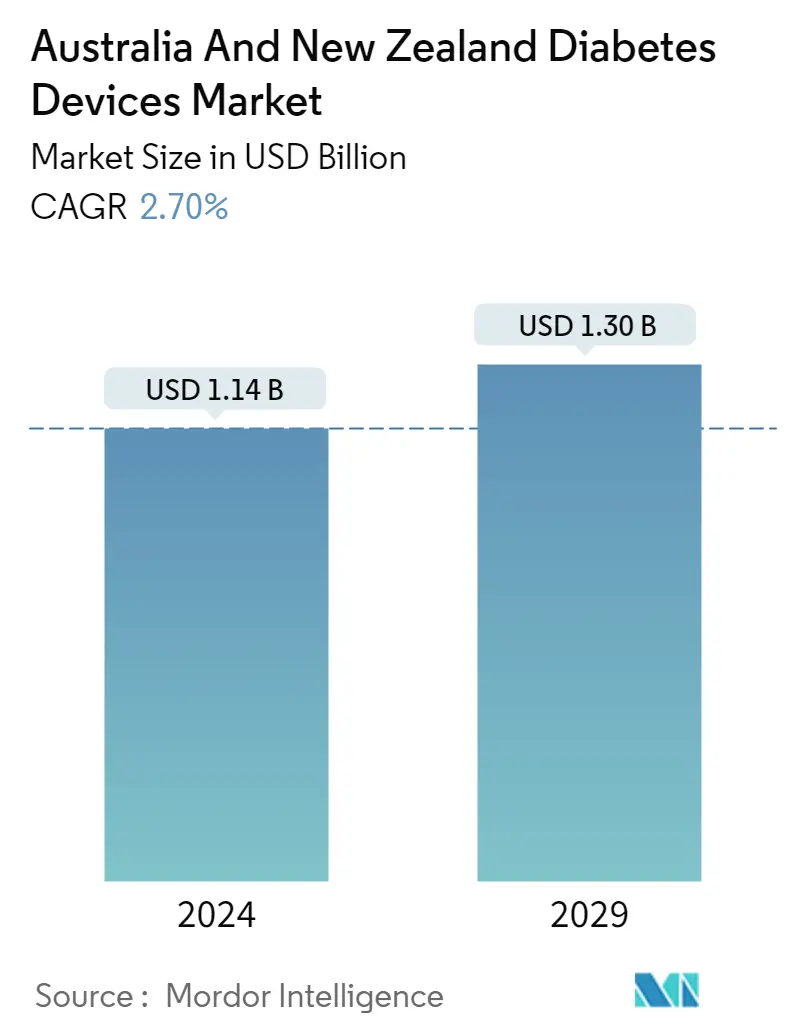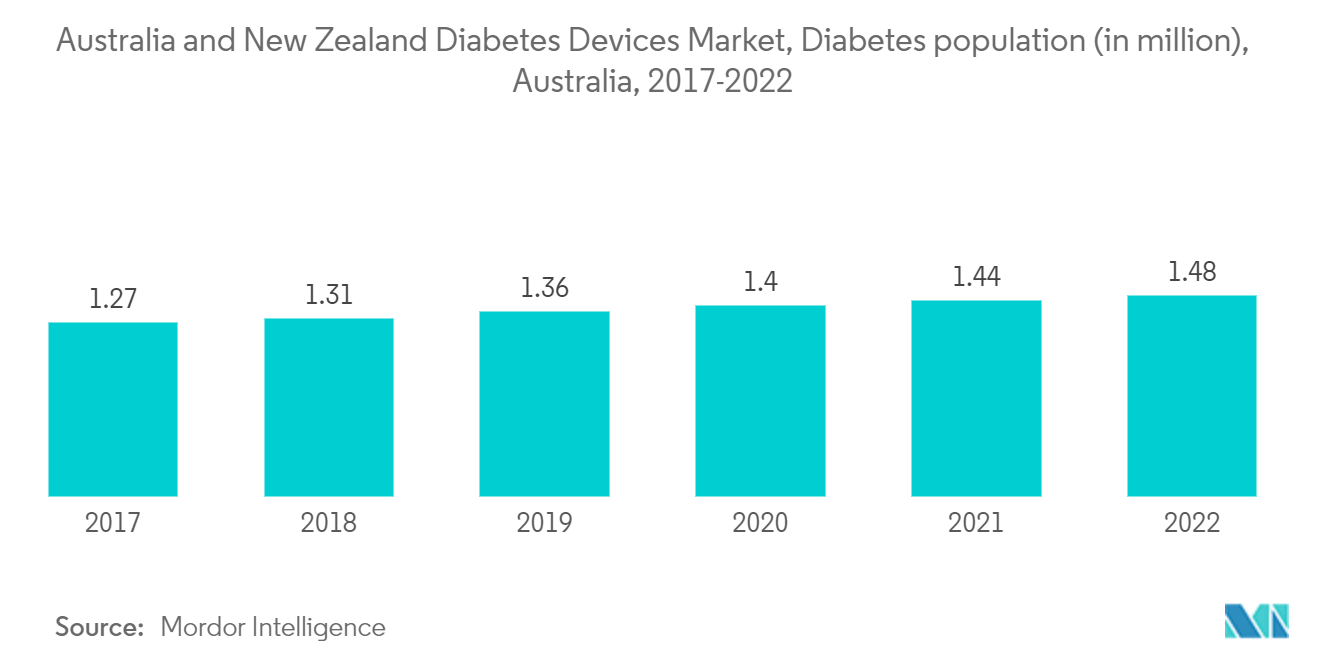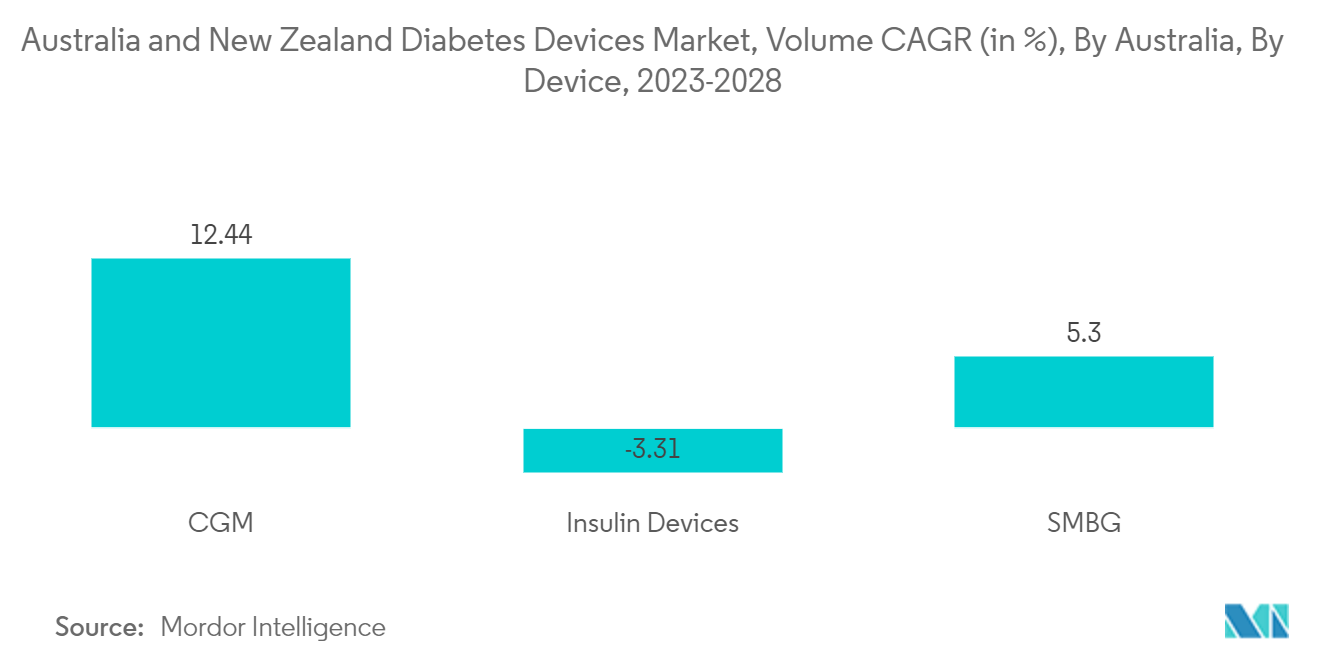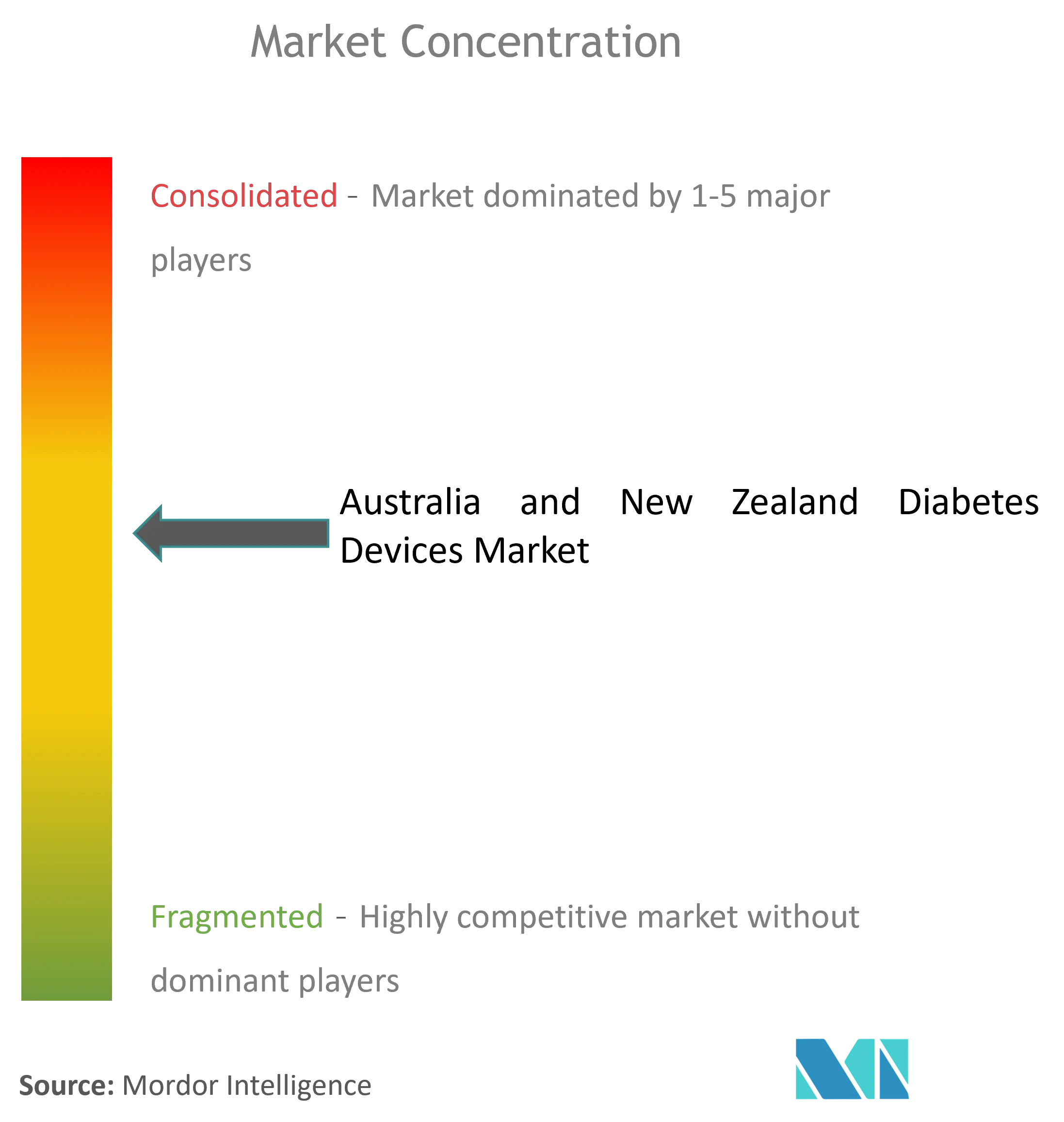Australia and New Zealand Diabetes Devices Market Size

| Study Period | 2018 - 2029 |
| Base Year For Estimation | 2023 |
| Forecast Data Period | 2024 - 2029 |
| Market Size (2024) | USD 1.14 Billion |
| Market Size (2029) | USD 1.30 Billion |
| CAGR (2024 - 2029) | 2.70 % |
Major Players
*Disclaimer: Major Players sorted in no particular order |
Australia and New Zealand Diabetes Devices Market Analysis
The Australia And New Zealand Diabetes Devices Market size is estimated at USD 1.14 billion in 2024, and is expected to reach USD 1.30 billion by 2029, growing at a CAGR of 2.70% during the forecast period (2024-2029).
- A holistic study of the market studied has been carried out by incorporating various factors, extending from country-specific demographic conditions and business cycles to market-specific microeconomic influences, which were needed to analyze future trends.
- The research uncovers many paradigm shifts in the market studied, in terms of regional competitive advantage and dynamics, primarily to services.
Australia and New Zealand Diabetes Devices Market Trends
Rising diabetes prevalence in Australia and New Zealand.
The youth are more likely to get diabetes early due to their younger ages and longer diabetes durations, which lowers their quality of life, reduces life expectancy, and raises societal healthcare expenditures. As a result, increased consumer demand for diabetes care devices and rising adoption rates have driven the market. Additionally, as type-2 diabetes patients throughout the world become more aware of the disease, the demand for diabetic devices has been growing quickly. Between 1991 and 2021, the prevalence of diabetes in Australia more than quadrupled.
Maintaining blood glucose levels within a predetermined target range is one of the key goals of diabetes therapy. It may be done by combining meals with activity, lifestyle changes, and diabetes medications. Readings from blood glucose monitors give the data needed to choose the optimum diabetes care plan. A person's risk of acquiring a variety of diabetes-related problems, including diabetic retinopathy, heart disease, renal disease, etc., can be decreased by maintaining blood glucose levels within a target range. The frequency with which diabetics who use insulin check their blood glucose levels varies depending on a variety of variables. Patients prefer self-monitoring blood glucose meters over continuous glucose monitors (CGM) because they are less expensive and simpler to use. The typical glucose meter efficiency is between six months and three years, despite the fact that test strips are only meant to be used once. The release of new lancet devices that cause customers less discomfort is projected to boost market growth since the market's acceptance rate is anticipated to rise over the course of the forecast period. Strict government rules and supportive recommendations from the WHO about the use of diabetes drugs and gadgets to promote patient compliance and decrease diabetic complications are encouraging businesses to develop novel solutions.
The increasing diabetes population in both countries is driving the market.

The CGM devices segment Witnessed the Highest Growth Rate Over the Forecast Period.
Continuous glucose monitors (CGM) evaluate the body's glucose levels in real-time by detecting the presence of glucose in tissue fluid. In contrast to a blood glucose meter (BGM), which detects the blood glucose level at a predetermined moment (when you prick your finger), a CGM generally delivers a fresh glucose reading every five minutes, or 288 times each day.
Medical assistance does not cover CGM devices in New Zealand, and few payment options are available at public healthcare institutions. People regularly turn to private charities like Givealittle to generate money for the medical costs linked to the CGM devices needed for children with type-1 diabetes who only need one device. In New Zealand, diabetic individuals using CGM devices pay between USD 4,000 and USD 5,000 out of their own monthly cash. Diabetes has a significant impact on systemic health expenses, but individual health expenditures are rising more quickly to make up the difference. Private spending accounts for 20% of all health spending in New Zealand, of which 12-15% is directly out-of-pocket. In addition to the explicit costs, there are significant personal losses from missed income due to problems restricting activity and lost non-salary production from the inability to complete duties like housework or volunteer work. According to projections, missed personal salaries were likely to cost the economy USD 562 million in 2020, USD 755 million in 2040, and USD 334 million in non-salary economic losses during the same period.
The Australian government has launched the National Diabetes Services Scheme (NDSS). After the patient has enrolled in the NDSS, subsidized blood glucose monitoring items are available. Everyone in Australia with a Medicare card and a diabetes diagnosis is eligible for free registration with the NDDS. Both the patient and a member of the medical staff must fill out forms for the NDSS. The NDSS provides financial support for the blood glucose testing strips. Certain individuals with type-1 diabetes are qualified to use subsidized FGM and CGM.
Thus, the above-mentioned factors are expected to drive segment growth over the forecast period.

Australia and New Zealand Diabetes Devices Industry Overview
The Australia and New Zealand diabetes devices market is highly fragmented, with multiple players. Market leaders such as Eli Lilly, Sanofi, Novo Nordisk, and Dexcom are focusing on product launches and technological collaboration to increase their foothold in the market.
Australia and New Zealand Diabetes Devices Market Leaders
-
Novo Nordisk
-
Dexcom
-
Abbott
-
Sanofi
-
Medtronic
*Disclaimer: Major Players sorted in no particular order

Australia and New Zealand Diabetes Devices Market News
- November 2022: Eli Lilly and Company announced that it was to roll out its first connected platform, the Tempo Personalized Diabetes Management Platform. The technology aimed to help adults living with type-1 or type-2 diabetes and clinicians make informed, data-backed decisions to manage treatment with Lilly insulins. The platform consisted of three key components: the Tempo Smart Button; a compatible app, TempoSmart; and a prefilled insulin pen, Tempo Pen, which worked together to deliver personalized guidance for adults with diabetes.
- October 2022: Dexcom, Inc. and its New Zealand subsidiary, New Zealand Medical and Scientific Ltd. Diabetes, announced that the Dexcom G7 Continuous Glucose Monitoring System was available for people with diabetes aged two years and older in New Zealand.
Australia and New Zealand Diabetes Devices Market Report - Table of Contents
1. INTRODUCTION
- 1.1 Study Assumptions and Market Definition
- 1.2 Scope of the Study
2. RESEARCH METHODOLOGY
3. EXECUTIVE SUMMARY
4. MARKET DYNAMICS
- 4.1 Market Overview
- 4.2 Drivers
- 4.3 Restraints
-
4.4 Porter's Five Forces Analysis
- 4.4.1 Bargaining Power of Suppliers
- 4.4.2 Bargaining Power of Consumers
- 4.4.3 Threat of New Entrants
- 4.4.4 Threat of Substitute Products and Services
- 4.4.5 Intensity of Competitive Rivalry
5. Market Segmentation
-
5.1 Monitoring Devices
- 5.1.1 Self-Monitoring Blood Glucose
- 5.1.1.1 Glucometer Devices
- 5.1.1.2 Blood Glucose Test Strips
- 5.1.1.3 Lancets
- 5.1.2 Continuous Glucose Monitoring
- 5.1.2.1 Sensors
- 5.1.2.2 Receivers
-
5.2 Management Devices
- 5.2.1 Insulin Pump
- 5.2.1.1 Insulin Pump Device
- 5.2.1.2 Insulin Pump Reservoir
- 5.2.1.3 Infusion Set
- 5.2.2 Insulin Syringes
- 5.2.3 Insulin Cartridges in Reusable Pens
- 5.2.4 Disposable Pens
- 5.2.5 Jet Injectors
-
5.3 Geography
- 5.3.1 Australia
- 5.3.2 New Zealand
6. COMPETITIVE LANDSCAPE
-
6.1 Company Profiles
- 6.1.1 Abbott
- 6.1.2 Roche
- 6.1.3 Dexcom
- 6.1.4 Becton and Dickenson
- 6.1.5 Medtronic
- 6.1.6 Insulet
- 6.1.7 Ypsomed
- 6.1.8 Novo Nordisk
- 6.1.9 Sanofi
- 6.1.10 Eli Lilly
- *List Not Exhaustive
- 6.2 Company Share Analysis
7. MARKET OPPORTUNITIES AND FUTURE TRENDS
** Subject To AvailablityAustralia and New Zealand Diabetes Devices Industry Segmentation
Devices are more user-friendly and minimally intrusive, ranging from blood glucose meters and continuous glucose monitoring (CGM) to advanced insulin pumps. The New Zealand diabetes devices market is set to register a CAGR of more than 10% during the forecast period. The Australian and New Zealand diabetes devices market is segmented into management devices (insulin pumps, insulin syringes, insulin cartridges, disposable pens, and jet), monitoring devices (self-monitoring blood glucose and continuous glucose monitoring), and geography (Australia, New Zealand). The report offers the value (in USD million) and volume (in units million) for the above segments. The report will provide a segment-wise breakdown (value and volume) for all the countries covered under the table of contents.
| Monitoring Devices | Self-Monitoring Blood Glucose | Glucometer Devices |
| Blood Glucose Test Strips | ||
| Lancets | ||
| Monitoring Devices | Continuous Glucose Monitoring | Sensors |
| Receivers | ||
| Management Devices | Insulin Pump | Insulin Pump Device |
| Insulin Pump Reservoir | ||
| Infusion Set | ||
| Management Devices | Insulin Syringes | |
| Insulin Cartridges in Reusable Pens | ||
| Disposable Pens | ||
| Jet Injectors | ||
| Geography | Australia | |
| New Zealand |
Australia and New Zealand Diabetes Devices Market Research FAQs
How big is the Australia And New Zealand Diabetes Devices Market?
The Australia And New Zealand Diabetes Devices Market size is expected to reach USD 1.14 billion in 2024 and grow at a CAGR of 2.70% to reach USD 1.30 billion by 2029.
What is the current Australia And New Zealand Diabetes Devices Market size?
In 2024, the Australia And New Zealand Diabetes Devices Market size is expected to reach USD 1.14 billion.
Who are the key players in Australia And New Zealand Diabetes Devices Market?
Novo Nordisk, Dexcom, Abbott, Sanofi and Medtronic are the major companies operating in the Australia And New Zealand Diabetes Devices Market.
What years does this Australia And New Zealand Diabetes Devices Market cover, and what was the market size in 2023?
In 2023, the Australia And New Zealand Diabetes Devices Market size was estimated at USD 1.11 billion. The report covers the Australia And New Zealand Diabetes Devices Market historical market size for years: 2018, 2019, 2020, 2021, 2022 and 2023. The report also forecasts the Australia And New Zealand Diabetes Devices Market size for years: 2024, 2025, 2026, 2027, 2028 and 2029.
Australia and New Zealand Diabetes Devices Industry Report
Statistics for the 2024 Australia and New Zealand Diabetes Devices market share, size and revenue growth rate, created by Mordor Intelligence™ Industry Reports. Australia and New Zealand Diabetes Devices analysis includes a market forecast outlook to 2029 and historical overview. Get a sample of this industry analysis as a free report PDF download.



